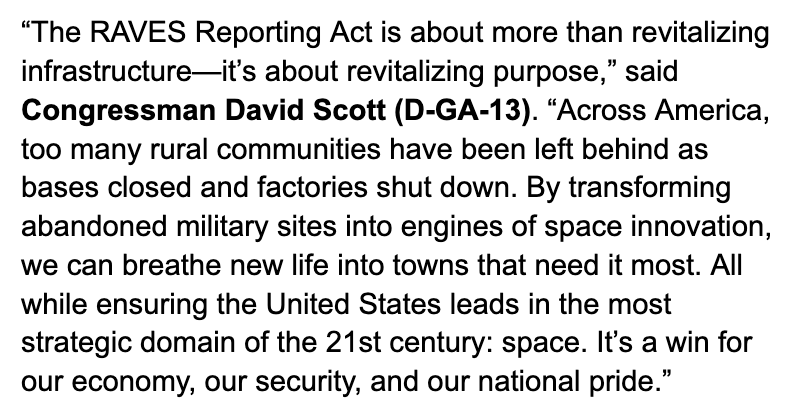From Rust Belt to Asteroid Belt: How the RAVES Act Turns Abandoned Bases into Strategic Assets
- Security and Democracy Forum

- Aug 4
- 3 min read
Sometimes the best way to solve a problem is to realize it might be the solution to another sticky issue. Across rural America, decommissioned military bases and shuttered factories sit idle. They’re remnants of an earlier era of national purpose and industrial strength. Meanwhile, the United States faces an urgent challenge in space: China’s rapid push to dominate the final frontier. What if these aging facilities could be the foundation of a new space-powered revival?

That is the bold idea behind the Rural American Vitalization in Extraterrestrial Space (RAVES) Reporting Act, a bipartisan bill introduced by Representative David Scott of Georgia and co-sponsored by Representative Jack Bergman of Michigan. The legislation directs the Department of Defense to evaluate its own inventory of abandoned or underutilized facilities and assess whether they could be converted into manufacturing hubs for the U.S. space industry. In short, it proposes taking assets we already own and putting them to work in service of a 21st-century national mission.
This approach tackles two persistent problems simultaneously. First, the economic decline of rural communities. Over recent decades, manufacturing offshoring and military base closures have left many American towns without an economic engine. The Department of Defense, which has not conducted a formal Base Realignment and Closure (BRAC) round in years, still holds many of these sites. Rather than allowing them to deteriorate further, the RAVES Act asks what else they might become.

Second, the bill responds to escalating competition with China over space dominance. Beijing is investing heavily in its lunar program, planning to land astronauts on the moon before decade's end and establish a permanent presence. In 2007, China destroyed one of its own satellites as part of an anti-satellite missile test, signaling its willingness to treat space as a military domain. The United States cannot maintain space dominance without the industrial capacity to build and launch the systems that make it possible.

Revitalizing rural infrastructure to meet space industry needs is a smart use of public resources. The RAVES Act would require the Department of Defense to identify and certify abandoned sites that could support space manufacturing. It also encourages coordination with NASA and the private sector to examine how these locations might help relieve supply chain pressures and provide affordable facilities for the growing commercial space sector.
This is not just about rockets and satellites. Space manufacturing could support high-precision components, advanced materials, and next-generation communications systems. These are the building blocks of economic growth, national security, and technological leadership.

At its core, the RAVES Act represents rare legislation: practical, patriotic, and forward-looking. It leverages existing assets to meet current needs, draws a direct line between economic opportunity at home and strategic competition abroad, and reflects the best of American problem-solving.
This proposal focuses on infrastructure, which is a great first step. Workforce development will determine the success of any conversion projects. Rural communities must be equipped to train and retain skilled workers for this new economy through strong partnerships with community colleges, apprenticeship programs, and STEM initiatives. The next phase should prioritize education and workforce investments to prepare the coming generation of space engineers, machinists, and operators.
Congress should pass the RAVES Act and begin laying the foundation for what comes next. The path to the stars might just begin in a forgotten warehouse on the edge of a small town, waiting for a second chance to serve the nation.




Comments